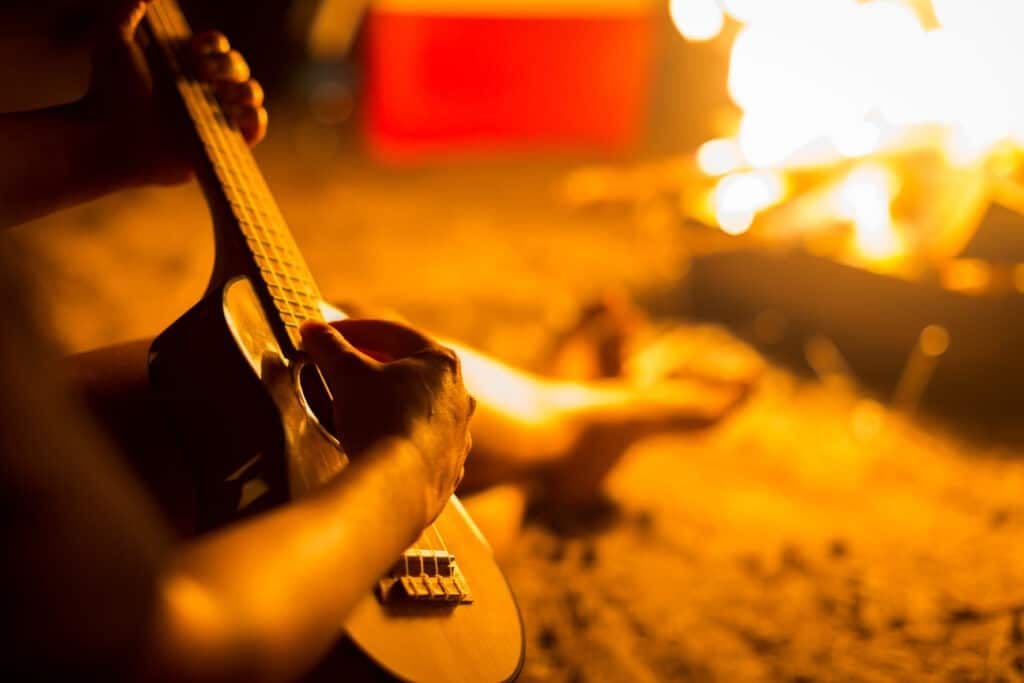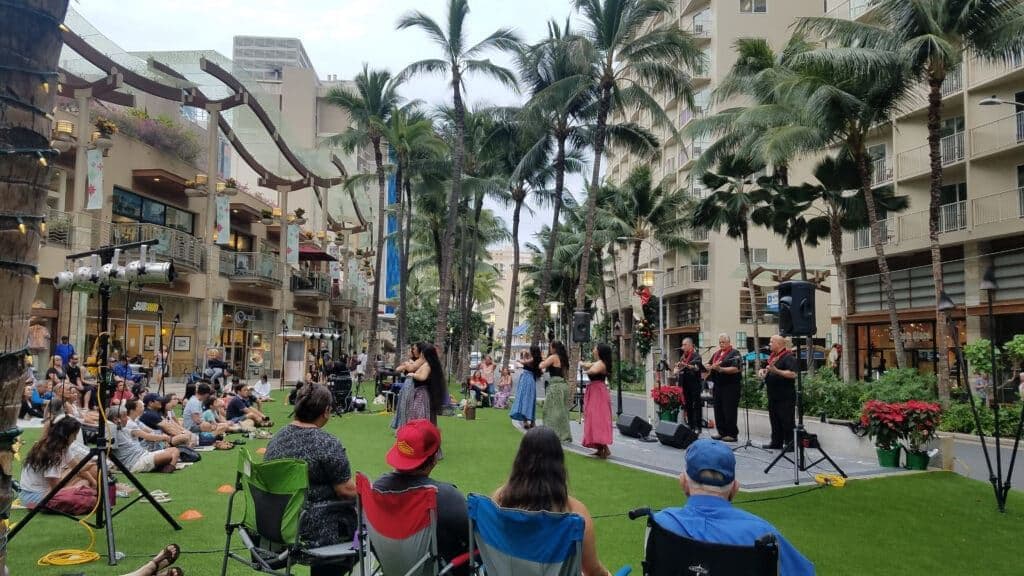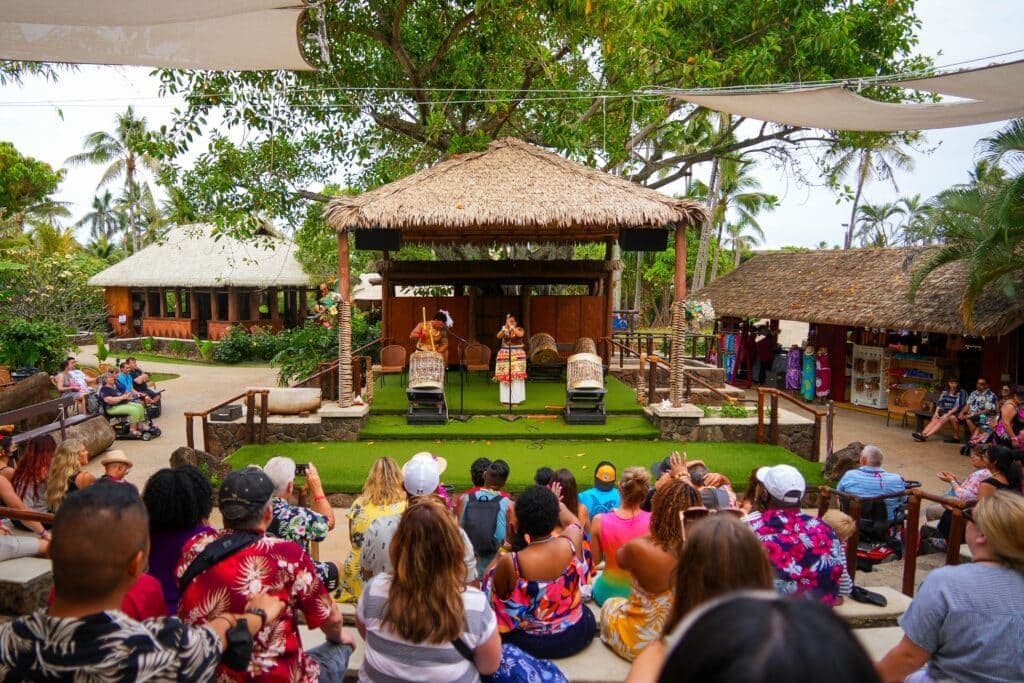By M. Kruse
When you land in Hawaiʻi, one of the first things you’ll notice is the sound. It’s not just the rustle of palm trees or the gentle crash of waves — it’s the music. Hawaiian music tells the stories of the islands. It carries the aloha spirit in every strum of the ʻukulele, every falsetto note, and every drumbeat that reaches back to ancient times, connecting it to the broader category of world music.

Beachfront jam session (Shutterstock)
Hawaiian music is a unique and captivating genre that originated in the islands. Traditional Hawaiian music is characterized by its simple structure and reverent, haunting beat, often evoking a deep sense of connection to the land and its people. Over time, Hawaiian music has evolved, incorporating diverse styles such as rock ’n’ roll, rap, jazz, and Jawaiian — a Hawaiian form of reggae music that has gained popularity worldwide.
The influence of different cultures has resulted in a unique blend of styles that make Hawaiian music truly special. Vocal styles are distinct, and the ʻukulele is a fundamental part of Hawaiian music and culture, adding a light, playful sound.
Hawaiian music is far from one-size-fits-all. It’s rich with styles that have evolved over time, blending native traditions with outside influences.
Traditional Hawaiian Music: Rooted in chants known as mele, they’re often accompanied by ancient percussion like the ipu (gourd drum) or pūʻili (bamboo sticks). This style recounts legends, honors ancestors, and marks important events. You’ll hear this music during hula performances and cultural ceremonies.
Slack Key Guitar (Kī Hōʻalu): This is a distinctly Hawaiian style of guitar playing where strings are loosened, or “slacked,” to produce open tunings. The result is a mellow, flowing sound that matches the rhythm of island life.
Falsetto Singing (Leo Kiʻe Kiʻe): Male singers often reach high, haunting notes in this traditional vocal style, which showcases emotion and storytelling. It’s a staple at Hawaiian music festivals and competitions.
Contemporary Hawaiian Music: A blend of reggae, rock, jazz, and R&B with Hawaiian roots. Artists like Israel Kamakawiwoʻole and Jack Johnson brought Hawaiian music to the global stage. Today’s playlists often feature island reggae — or “Jawaiian”— as well as upbeat pop from local bands.
Kanikapila: A kanikapila is a style of informal jam session, often held on beaches or in backyards after a potluck. It’s spontaneous, soulful, and full of laughter.
As one Twitter fan shared, “The best music moment of my trip to Maui? A sunset kanikapila on the beach with strangers who felt like family by the end. #HawaiianVibes” — @IslandStrummer
Kanikapila comes from the Hawaiian words kani (sound) and pila (instrument). It’s less a performance and more an experience. Locals gather with instruments — ʻukulele, guitar, maybe even a washtub bass — and play for the joy of it. No stage, no tickets, just music under the stars. You’re likely to hear classic Hawaiian songs, old hapa haole tunes, or even Bob Marley covers. Visitors who stumble across a kanikapila often say it’s the highlight of their trip.
One visitor on Instagram wrote, “Stumbled on a beach jam in Waikīkī. Ended up dancing barefoot with strangers. Unreal! #kanikapila #Hawaiianmusic” — @BeachSoulSessions
If you want to join in, many resorts, cultural centers, and local parks host casual music nights. Some kanikapila events even welcome beginners — just bring your aloha spirit and an instrument if you’ve got one.
Whether you’re listening to a formal concert or a spontaneous jam session, you’ll hear these musical instruments shaping the sound of Hawaiian music.
ʻUkulele: Light, playful, and iconic, the four-stringed ʻukulele is central to Hawaiian music. Introduced by Portuguese immigrants in the late 19th century, Hawaiians made it their own, naming it ʻukulele — often translated as “jumping flea” for the way fingers dart across the fretboard. Today, you’ll find different sizes like soprano, concert, tenor, and baritone, each offering a slightly different tone.
Slack Key Guitar (Kī Hōʻalu): Played solo or with vocals, it’s warm and intimate. Musicians detune or “slack” the guitar strings to open tunings, creating unique harmonies. Unlike standard guitar styles, slack key emphasizes fingerpicking, which allows melodies, bass, and rhythm to be played at the same time.
Steel Guitar: Invented in Hawaiʻi by Joseph Kekuku in the 1880s, this instrument uses a metal slide to create smooth, gliding tones. Its emotional, almost vocal-like quality deeply influenced blues and country music on the mainland United States.
Ipu and Pahu Drums: Traditional hula is incomplete without percussion. The ipu is made from a hollowed gourd and used to mark time with rhythmic beats. The pahu, carved from coconut or breadfruit tree trunks and covered with sharkskin, produces deeper, more resonant tones. The pahu was traditionally considered sacred and used in ceremonies and storytelling through hula.
ʻOhe Hano Ihu (Nose Flute): A rare but beautiful wind instrument made of bamboo and played by blowing air through the nose. It was often used in courting rituals and lullabies.
Jaw Harp (ʻUkēkē): The only stringed instrument that is truly native to Hawaiʻi, the bow-shaped mouth harp was used to communicate secret messages in songs between lovers.
Modern Instruments: In reggae, Jawaiian, and pop-fusion Hawaiian music, you’ll also hear bass guitars, drum kits, keyboards, and synthesizers. These blend seamlessly with traditional sounds, expanding the reach of Hawaiian music across genres and generations.
“Can’t stop replaying the slack key guitar I heard at sunset in Lahaina. Something about that sound just hits different. #AlohaNights” — @TravelTunez

Honolulu beach music (Shutterstock)
Music festivals in Hawaiʻi are a fantastic way to experience the islands’ vibrant music scene. One of the most celebrated events is the ‘Ukulele Festival, held every July at the Kapiʻolani Park Bandstand. This festival celebrates the ʻukulele and its significance in Hawaiian music, bringing together artists of all ages to showcase their talents.
Another highlight is the Kona Slack Key Festival, held in September. This festival showcases the unique slack key guitar playing style, a staple of Hawaiian music that reflects the islands’ relaxed climate and culture. These festivals feature a mix of traditional and contemporary Hawaiian music, as well as other genres such as jazz and rock, providing a diverse musical experience.
Music festivals bring people together in the most joyful ways — celebrating local talent and island culture. Whether you’re lounging on a beachside lawn or dancing under the stars, these events offer the perfect way to relax and connect with Hawaiʻi’s rich musical heritage. It’s an experience that stays with you — vivid, vibrant, and undeniably Hawaiian.
From bustling resort stages to quiet roadside cafés, live music in Hawaiʻi is easy to find if you know where to look. Here are some of the best spots:
Waikīkī, Oʻahu: Almost every night, you’ll find live music at venues like the Royal Hawaiian Hotel’s Mai Tai Bar or Duke’s Waikīkī. Check out free beachfront hula shows at Kūhiō Beach Hula Mound.
Polynesian Cultural Center: Located in Lā‘ie, Oʻahu, PCC offers immersive cultural experiences complete with traditional music and dance performances. The Aliʻi Lūʻau and Hā: Breath of Life show feature exceptional performers and vocalists.
Maui Arts & Cultural Center: A top venue for both local legends and touring artists, from Hawaiian slack key players to jazz ensembles.
Big Island Luaus: Many luaus in Kailua-Kona pair music, hula, and storytelling for a full cultural evening. For an intimate vibe, head to the Blue Dragon Tavern in Kawaihae.
Kauaʻi’s Smith Family Garden Luau: This long-running luau includes performances of traditional Hawaiian chants, hula, and contemporary music.
Free Community Events: Watch for kanikapila sessions, First Friday art nights, farmers markets, and even block parties. You never know when or where a group of musicians might gather.
For upcoming live shows, local event calendars and hotel concierge desks are great resources. Also, visit Hawaii Public Radio for weekly music features and artist interviews.

Open-air theater at the Polynesian Cultural Center (Shutterstock)
No matter which island you visit, Hawaiian music will be part of your journey:
Attend a Festival: The Merrie Monarch Festival in Hilo (celebrated each spring) is the Olympics of hula. It’s a great way to hear traditional Hawaiian music in its purest form.
Take a Lesson: Many resorts and cultural centers offer ʻukulele classes. Even a 30-minute intro session will have you strumming something sweet.
Support Local Artists: Buy CDs, stream music on Hawaiian platforms like Nā Hōkū Hanohano Awards, and follow local performers on social media to catch pop-up shows.
Respect the culture: Hawaiian music often shares family stories and cultural history. Treat performances with aloha — listen, learn, and don’t interrupt.
Dress for the occasion: If you’re heading to a luau or concert, casual aloha wear is fine, but skip the swimsuit.
Ask locals: The best music spots aren’t always advertised. Chat with your Uber driver, bartender, or barista — they’ll know where the good jams are.
Whether you’re road-tripping the Big Island, lounging in Waikīkī, or hiking in Hāna, let the soundtrack of Hawaiian music set the tone for your trip. It brings people together. It tells the story of the land. And if you’re lucky, you’ll find yourself dancing at a beachside kanikapila under the stars.
Join our newsletter for travel inspiration, insider tips and the latest island stories.
By subscribing, you agree to receive emails from Hawaii.com. You can unsubscribe anytime. See our Privacy Policy.